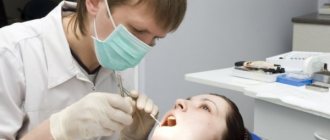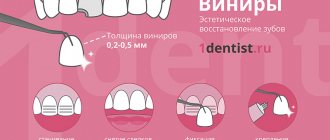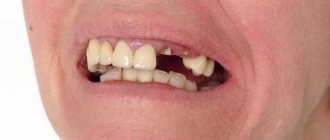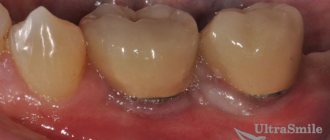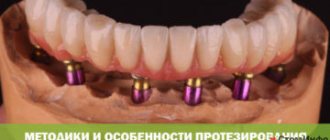Causes of bad breath
Most often, an unpleasant odor appears under the crown for the following reasons:
- Loose fit to the gum. If there is even a small gap, food particles will always get into it.
The usual method, using a brush and rinsing, cannot be cleaned, so organic matter accumulates all the time. Every day, pathogenic microbes multiply on the substrate, provoking putrefactive processes with a characteristic odor. - Depressurization at the junction of the tooth and crown. This happens if the prosthesis is put on incorrectly, or the cement has partially crumbled.
Bacteria-pathogens enter the formed cavities, which provoke inflammation of the gums. Secondary caries may also develop, resulting in an unpleasant odor. - Depressurization of the connection between a tooth and a metal-ceramic crown. When the integrity of the cement layer is broken and air pockets appear, oxygen and saliva penetrate into them. In a humid environment, the process of metal oxidation occurs, hence the unpleasant aroma.
Oxidized metal can be a source of inflammation of the gum tissue.
- Lack of protection after grinding a tooth. Once the tooth is ground down, it takes some time before the crown is installed.
While waiting, the doctor puts on a temporary prosthesis or treats it with special cement. This is done in order to prevent microbes from entering the dental tissue. If this step is missed, pathogens will settle in the stump, which will subsequently lead to rotting and odor. - The prosthesis is made or installed incorrectly. Due to some circumstances (no necessary equipment in the laboratory, lack of qualifications of the technician or lack of experience of the dentist, etc.), the crown is installed in violation of technology.
- Installing a crown on a decayed tooth that needed to be removed. When it is necessary to install a bridge, but one of the supporting teeth must be removed, he is offered to restore it with a crown instead of the expensive installation of an implant.
Soon the tooth still deteriorates, its root breaks, and the crown falls off. Therefore, if the doctor recommends removing a tooth, it is better to remove it immediately. - Poor oral hygiene. Some dentures require careful care, constant cleaning of food debris to prevent the growth of pathogenic microbes.
- Untreated caries or pulpitis. Before installing a crown, all teeth in your mouth should be treated. The presence of tooth decay will aggravate the situation by allowing pathogens to grow in the mouth.
- Poor removal of pulpitis. When the tooth canal is poorly filled, a granuloma (cyst) - a cavity with pus - can develop at the tops of its roots.
Also, the development of granuloma can be caused by poor obturation of the root canals, in which the cement is filled loosely, with gaps. - Permanent gum irritation. When a crown is installed incorrectly, it continually impacts the soft tissue of the gums, causing inflammation and swelling.
In addition to the smell from the inflammatory process, severe pain will also be felt.
A qualified dentist can help determine the exact cause of bad breath, so it is best to seek help immediately.
Fluorosis
This is a disease that is characterized by excessive fluoride content in the tissues of the body. And its excess leads to the destruction of not only bones, but also teeth. That is why installing crowns will provide reliable protection. True, the measure will be effective only at the initial stage and in case of pathology of only a few teeth - after all, it is impossible to place crowns on the entire dentition at once (expensive, time-consuming and too difficult).
Fluorosis
In order to determine the feasibility of installing a crown, the patient, of course, should visit the dental office. Moreover, it is better to consult with several specialists - see our selection of the TOP 15 best clinics for dental prosthetics. Unfortunately, quite often there are situations when the doctor suggests installing a dental crown too early and there is still an opportunity to very successfully fight for the preservation of living tooth tissue.
Patient review about basal implantation WITHOUT bone tissue augmentation.
Notice
: Undefined variable: post_id in
/home/c/ch75405/public_html/wp-content/themes/UltraSmile/single-item.php
on line
45 Notice
: Undefined variable: full in
/home/c/ch75405/public_html/wp-content /themes/UltraSmile/single-item.php
on line
46
Rate this article:
( 1 ratings, average: 5.00 out of 5)
crown
Symptoms of rotting
It is possible to understand that irreversible changes are occurring in the tooth precisely because of the smell that appears, since there will be no pain. The sensitivity of the tooth disappears when, during the period of preparation for prosthetics, the doctor removes the neurovascular bundle (depulps the tooth).
If there is a suspicion that the tooth is rotting under the crown, pay attention to whether the following symptoms are present:
- First, an unpleasant taste appeared in the mouth, followed by a bad smell that could not be hidden even from the interlocutors. Neither mouthwash nor chewing gum can mask the stench.
- Gaps have formed under the crown, and from time to time you have to fish out dietary fiber from them. But some of them remain to rot and decompose, causing an inflammatory process and an unpleasant odor.
- The tooth under the crown has darkened.
- If you try to run your tongue along the crown and around it, you can feel the depression in which food is clogged.
- The gums around the artificial tooth are inflamed, and soft tissue swelling is observed.
- Sometimes you can feel significant pain if the stump under the crown has retained its nerve endings.
Attention! If at least one symptom is noticed, you should immediately contact the clinic to begin treatment of the damaged tooth.
If you delay resolving the issue, then in addition to the formation of pus under the crown, you may encounter a purulent tooth root cyst or gumboil (pus breaks into the gum and forms a lump). This abscess is removed surgically.
In addition to everything, the presence of rotting in the mouth means that the infection, along with the blood, circulates throughout the body, gradually destroying internal organs and joints. One rotten tooth can cause chronic inflammatory processes in the ENT organs, blepharitis, osteomyelitis, etc.
In the most advanced cases, there is nothing left but to remove the completely destroyed root. This means incurring huge costs for installing an implant or bridge.
Honestly about depulpation: should you be afraid of the nerve removal procedure?
If caries is not cured in time, and there is a deep carious lesion, the only way out is to remove the dental nerve. As caries develops, microorganisms violate the integrity of the enamel, as a result of which the nerve is exposed and reacts to any influence with unbearable pain.
Depulpation
(nerve removal) is a modern way to preserve a unit of dentition without implantation.
When nerve removal is indispensable
In modern dental practice, both complete and partial resection are used. Indications for the procedure:
- deep carious tissue damage;
- chronic pulpitis (including asymptomatic);
- bactericidal infection spread by the apex of the tooth root;
- the presence of an extensive pulp area, the threat of developing periodontitis or transition to periodontitis;
- trauma leading to nerve exposure and tooth destruction;
- the need to correct a medical error;
- the need for prosthetics with low crowns.
Unbearable pain can also be an indication for depulpation.
The dentist will never prescribe such a serious intervention as long as it is possible to save the tooth.
Important
: problematic “eights” when affected by caries, as a rule, are removed. This is due to the location of the “wisdom” teeth at the end of the dentition, which makes cleaning them from plaque and stone and filling the canals very problematic. Indications for removal are also the wrong direction of eruption, displacement of the dentition, malocclusion, and the development of pulpitis.
What is the dental nerve called?
In dentistry, the dental nerve, or pulp, is a complex structure - an interweaving of nerves and vessels located inside the root and crown of the tooth and responding to external stimuli.
Depulpation allows you to save the damaged tooth, but has negative consequences:
- Since the pulp acts as a barrier to infections, removing the nerve deprives the tooth of the necessary level of blood supply and mineralization, which shortens its “life.”
- A tooth deprived of a nerve loses sensitivity, the enamel becomes more fragile and faded, and the strength of the tooth decreases.
Stages of the depulpation process
- X-ray – necessary to assess the condition of the pulp, the number, length and branching of the canals to be filled.
- Anesthesia - local or complete anesthesia completely covers the issue of pain when removing a nerve (it doesn’t hurt!). At the same time, general anesthesia is used relatively rarely - when treating children, with true dental phobia, etc.
- Installation of a rubber dam - a latex film for insulating a tooth. A modern solution to improve the dentist’s working conditions and protect against the possible spread of microorganisms through saliva.
- The actual removal of the nerve is the excision of tissues affected by caries, opening the pulp chamber and extracting the nerve with a special instrument (pulpoextractor). In modern practice, this is a careful cutting of the pulp without affecting sensitive areas.
- Installation of a temporary filling (for a period of 1-2 weeks).
- Control x-ray.
If the x-ray and the condition of the tooth are satisfactory, after the control period a permanent filling is installed.
Depulpation before prosthetic crowns
Depulpation is unconditional if there is serious tooth decay. It is preferable to remove the dental nerve during prosthetics in the following cases:
- The size of the teeth determines the low position of the crown (too small or short teeth);
- The inclination of the prosthetic tooth is from 15°;
- Increased sensitivity of teeth;
- According to aesthetic requirements.
The need to remove the dental nerve during prosthetics is dictated by deep removal of the top layer of dental tissue: if the doctor is not sufficiently qualified, heating or touching the nerve can cause an attack of unbearable pain. However, cases of nerve-sparing crown installation also occur in modern dental practice.
If over time the nerve under the crown becomes bothersome, it is possible to remove the pulp through the top of the crown and fill the hole after removal.
The danger of such a procedure is associated with the risk of complications in the future due to surgery on the exposed dental nerve.
About dental anesthesia
Standard dental practice is an injection of anesthetic; Taking tablet analgesics before going to the dentist is not recommended, as it leads to a decrease in the effectiveness of anesthesia (usually the effect of an anesthetic injection is 45 minutes). For patients suffering from a fear of injections, it is possible to use paste anesthesia, which has a similar effect.
The choice of anesthesia is up to the dentist; Taking into account the individual pain sensitivity threshold of each patient, the standard dose is sometimes doubled or even tripled. With proper selection of an anesthetic, discomfort during the procedure for the patient is excluded.
Why can a tooth hurt after pulp removal?
This often happens: the nerve has already been removed, but the pain remains. Such manifestations are acceptable in the first 3-4 days as a natural reaction of the body (for example, to clenching the jaws or to temperature stimuli).
Other causes of toothache after pulp removal:
- Careless cleaning of the canals, preservation and intensification of the inflammatory process due to incomplete removal of tissue damaged by caries.
- Using during the procedure a pulp extractor that is not suitable for the size of the canal or improper handling of the instrument.
- Broken dental instrument, retention of its remains in the upper part of the root (such a medical error leads to the need to remove the tooth).
- The occurrence of a secondary inflammatory process in the treated canals (residual pulpitis) occurs against the background of an incompletely removed nerve.
- Allergic reaction of the patient to the filling material.
Change in enamel color after nerve removal
If the dental clinic follows international depulpation protocols, such phenomena are excluded. However, in budgetary institutions there are frequent cases of using outdated practices.
The color of the enamel after nerve removal can be affected by:
- Improper preparation of the tooth for installation of a filling;
- Poor quality instrumental processing of channels;
- Low quality filling materials.
Thus, when using resorcinol-formalin paste (the use of the material is practiced in the treatment of baby teeth), the enamel acquires a pinkish tint; When using endomethasone, the tooth may turn yellow after a few years.
Possible complications
A medical error associated with poor-quality disinfection of the canal when removing a nerve can trigger the process of suppuration with subsequent transition to a periodontal abscess (in the absence of adequate treatment). This complication leads to the need for tooth extraction.
Other possible complications:
- Pain for several days after nerve removal. The duration of discomfort is individual for each patient; if pain persists for a long time, it is necessary to consult a doctor to re-open the canals and carry out disinfection.
- Increased bleeding of the canal occurs when the pulp extractor is removed after the pulp has been torn off. To avoid this phenomenon, many specialists carry out the procedure in stages with copious rinsing of the tissues with an antiseptic. Bleeding control is carried out directly at the appointment.
- The appearance of granuloma, fistula, cyst, gumboil.
Specific problems can arise if the material is applied incorrectly: if the filling extends beyond the boundaries of the root apex, the jaw nerve may be pinched.
If you experience pain in the lips and chin, you should urgently consult a dentist: a possible complication is facial paralysis.
Contraindications for depulpation
Diseases and conditions in which the dental nerve is not removed:
- stomatitis, purulent or inflammatory processes in the oral cavity;
- exacerbation of cardiovascular diseases;
- sore throat, flu, acute respiratory viral infections;
- infectious hepatitis;
- hemorrhagic diathesis;
- acute leukemia.
Refusal of treatment is also accepted if the patient has psycho-emotional disorders, in women - in the early and late stages of pregnancy.
Recommendations for the patient after depulpation:
- rinse your mouth with antiseptics prescribed by your doctor for 24 hours and avoid physical labor for at least two hours;
- delay eating to avoid possible injury or infection (during the first three hours it is recommended to drink warm boiled water through a straw);
- for five days, stop smoking and alcohol, do not take foods that irritate the mucous membrane (solid, hot/cold, spicy);
Remember: there are no folk remedies for removing the dental nerve! Even if it is possible to “kill” the nerve, pulp removal is only possible by a qualified dentist using medical instruments!
Contacting a dentist earlier will make the procedure less dangerous in terms of complications and less expensive in terms of money.
Source: https://Medistarspb.ru/chestno-o-depulpirovanii-nado-li-boyatsya-procedury-udaleniya-nerva
What to do if there is inflammation under the prosthesis?
When the cause of bad breath is an inflammatory process under the crown, the dentist offers the patient a series of procedures:
- First, the previous filling material is removed and the affected areas of the tooth are drilled.
- The area is treated with an antiseptic, and the inflammatory process is treated.
- A new filling is installed.
- When the infection subsides, the crown is placed again. If the previous one is suitable in quality and size, Html is used.
Treatment Options
The method of treatment is selected based on the degree of the complication that has arisen. The patient may face one of three options:
- If treated in a timely manner , when the stump and root are not affected, and the cause of the unpleasant odor is incorrect installation of the crown.
The prosthesis is removed, cleaned and installed in its original place. If the crown is made incorrectly, or it is necessary to remove a small amount of tissue destroyed by inflammation, it is replaced with another one. - If the stump is destroyed , but with the condition of maintaining the integrity of the tooth root, the stump tab is replaced. A new inlay requires a new crown.
- If the case is advanced , the tooth root has collapsed under the influence of pathogenic organisms - the tooth is completely removed.
A free-standing implant or bridge is installed in its place. The dentist determines which option is suitable in a particular case after conducting an examination and discussing the situation with the patient.
Important! You should only resort to tooth extraction as a last resort.
For example, a tooth is not saved when the inflammatory process has moved from the diseased tooth to the area adjacent to it. There is a large cyst, the presence of which can affect the entire jaw. Therefore, rotting is completely prevented, since it is very difficult to treat.
To prevent such a scenario, you should always remember about oral hygiene, timely visits to the dentist, and if something starts to bother you, do not put off visiting him.
Complications
A tooth lacking a nerve may experience pain for 2–14 days. At first, this is considered a normal reaction when chewing. Constant throbbing pain should alert you. The causes of this symptom are:
- incomplete removal of nerves;
- unsuitable filling material;
- insufficient cleaning of channels;
- inflammation of the gums after tissue injury during the procedure;
- radiating pain from a neighboring tooth;
- specific reaction of the body.
On this topic
- Depulpation
How long will a dead tooth last?
- Olga Alexandrovna Novikova
- August 15, 2020
A complication after the procedure may be the tooth extending beyond the upper part, resulting in granuloma and periodontitis. Any deviations from the normal state require an urgent visit to the doctor. In this case, an X-ray examination and urgent treatment are prescribed.
In case of a specific reaction of the body, anti-inflammatory therapy is carried out. If the reason is incorrectly performed depulpation, then a long process of correction will follow. The prosthesis will be removed, the canal will be cleaned again, and the nerves will be removed. In this case, the orthopedic design will be replaced with another one.
How to care?
Some people are quite careless about caring for dentures , because they do not consider them real teeth. But even the most expensive implants will deteriorate in just a couple of years without proper care. Although caries will not appear on synthetic material, an unpleasant odor and food deposits will remain if they are not cleaned.
It is important to be careful about the teeth adjacent to the crown. Daily cleaning will provide good prevention against diseases of the oral cavity and gastrointestinal tract.
It will also provide the opportunity to carry the implants for a maximum service life, while maintaining an attractive smile. Recommendations for caring for artificial teeth:
- Brushing your teeth twice a day, morning and evening . The movements of the brush are vertical, sweeping from top to bottom, from the gum to the edge of the tooth.
- Pay special attention to the gaps between the denture and the natural tooth , since food particles are deposited and rot in large quantities there. Clean the gap with dental floss or an irrigator (special brush). Use the thread daily before bed, the irrigator twice a week.
- After every meal, rinse your mouth . It is better not only with ordinary water, but also with a special rinse aid.
- Avoid eating solid foods . Like natural enamel, a ceramic structure can be damaged by strong mechanical impact - scratches and chips may appear on it.
- Try to reduce the consumption of coffee, coloring drinks and cigarette smoking , which contributes to the formation of plaque. Drinks can stain the surface of the tooth, and the smile will no longer be as snow-white as before.
- Do not consume too hot or cold food or drinks . This can cause cracks in the ceramic.
- Don't forget about gum care . Crowns and bridges are a serious burden for them. When brushing your teeth, do not forget to lightly massage your gums with a brush, ensuring normal blood circulation in them.
- Do not forget to clean your tongue , as microorganisms accumulate on it. To avoid bad breath, always finish brushing your teeth by cleaning your tongue.
Caring for dental crowns at home cannot be called difficult. It just needs to be regular and thorough.
If crowns are made and installed in accordance with all the rules, are not exposed to chemical or physical influence, are cleaned daily of food debris and periodically undergo professional dental care, their service life is calculated in decades.
Preventive crown care
In order not to provoke the accumulation of masses under the crown and cause tooth decay, it is necessary to maintain oral hygiene. A crown is an artificial structure and will require more care.
- Brush your teeth twice a day, including using special brushes for caring for dentures.
- Rinse your mouth after every meal.
- Floss regularly.
- Use toothpicks only when necessary. This is not at all a means of maintaining dental hygiene! Picking with a wooden stick, expanding cavities in teeth and crowns, is contraindicated.
If you have already had the sad experience of tooth decay under a denture, pay more attention to the alarm bells: pain under the crown, bad smell, taste of blood in your mouth. Make an appointment with a dentist; timely treatment will be shorter and cheaper than treatment for a neglected tooth.
If you realize that the tooth has begun to rot, remember that the process is irreversible. It will not be possible to cure inflammation with home methods. You should not wait until there is severe pain or the crown falls out in your sleep, with the risk of suffocation. A diagnosis from a doctor will help you cope with the problem.
Make an appointment at Dr. Lopaeva's clinic
Make an appointment
Or call +7(985)532-21-01
NuCalm – dental treatment without fear and stress, relaxation without medications
Why a tooth can rot under a crown, what needs to be done and where to go
Tooth hurts after nerve removal, root canal treatment
A tooth hurts under a crown, where to go in Moscow
What to do if the tooth root has deteriorated?
If the dental roots are rotten, the stump tab has no chance of holding on to them. The remains of the natural tooth are removed, and an implant or prosthesis is installed in this place.
If the adjacent teeth are intact, there is the option of installing a bridge system, which is fixed on two teeth around the hole. The use of removable dentures is also popular: made of nylon or acrylic.
The solution depends entirely on the patient’s ability to pay and his preferences in aesthetics. When consulting, the dentist offers all possible treatment methods and talks about the nuances of each of them.
If you think that the tooth under the crown has begun to rot, consult a doctor immediately. The process is not reversible, and the longer you ignore the problem, the greater the likelihood that the tooth will deteriorate completely. The problem cannot be cured or stopped at home - do not wait for the crown to fall out at night, when you are sleeping and could suffocate if it gets into the wrong throat.
